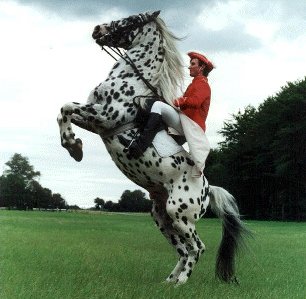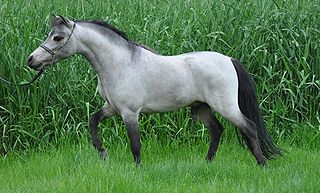The Priob or Ob is an endangered Russian breed of small horse from the Khanty-Mansi Autonomous Okrug, in Tyumen Oblast in the Russian Federation. It is distributed in the area of the Irtysh and lower Ob Rivers in western Siberia, and is a traditional breed of the indigenous people of that area, who used it for agriculture, for draft work, for forestry, and as a pack-horse.

The Ukrainian Riding Horse or Ukrainian Saddle Horse is a modern Ukrainian breed of warmblood sport horse. Breeding began in the years after the Second World War at the stud farm of Dnipropetrovsk in central Ukraine – at that time in the USSR – and later expanded to three other state stud farms. It derives from cross-breeding of Hanoverian, Thoroughbred and Trakehner stallions with local mares or with Hungarian Furioso, Gidran Arab or Nonius mares. It incorporates the last bloodlines of the extinct Orlov-Rostopchin or Russian Saddle Horse. It was bred to compete in show jumping, three-day eventing and dressage, but is also suitable as a general riding horse.

The Knabstrupper or Knabstrup is a Danish breed of warmblood horse. It is principally a riding horse, but is also used as a harness horse and as a circus animal.

The Pindos is breed of pony or small horse native to the Pindus mountain range in Thessaly and Epirus in Greece. It is also present in mountainous parts of Thrace and Macedonia. There is a feral herd near Neochori, Karditsa, close to Lake Plastiras.

The Yonaguni or Yonaguni uma (与那国馬) is a critically-endangered Japanese breed of small horse. It is native to Yonaguni Island, in the Yaeyama Islands in south-western Japan, close to Taiwan. It is one of eight horse breeds native to Japan.

The Dosanko (道産子), also known as the Hokkaido Horse and Hokkaido Pony, is one of the eight extant indigenous horse breeds of Japan, and the only one of the eight not critically endangered. It originated on the island of Hokkaido, in the far north of the country, and is found particularly along the Pacific (eastern) coast of the island. The people of Hokkaido may be nicknamed "Dosanko" after the horses.
The Poney du Logone is a breed of small horse or pony from the area of the Logone River in Chad and Cameroon, in west central Africa. It is particularly associated with the Musey or Moussey people of that region, and may also be known as the Poney Musey or Poney Mousseye.

The Latvian Horse is a purpose-bred warmblood horse breed from Latvia. Breeding began in Latvia in the early twentieth century, and a herd book was established in 1927. The breed was officially recognised in 1952. There are two types, sometimes called the Latvian Harness Horse and the Latvian Riding Horse. The harness type was predominant until about 1960, when demand for sport horses increased and more of the saddle type were bred.

The Gelderlander is a Dutch breed of warmblood horse. It was bred in the province of Gelderland in the Netherlands as a carriage horse capable also of farm work. It declined in popularity in the mid-twentieth century. In 1965 it was one of the foundation breeds of the Dutch Warmblood or KWPN, the other being the heavier Groninger horse from the north. It is registered in a division of the Royal Dutch Warmblood Horse Studbook, which also has divisions for the Dutch Warmblood and for the Dutch Harness Horse.

The Karabair is a long-established horse breed from Central Asia, and particularly from Uzbekistan and northern Tajikistan. It results from the cross-breeding of desert horses of Arabian or Turkmene type from the south with steppe horses from the north. It is a small, agile and versatile horse that can be used for riding or driving. It is well suited to local horse sports, and especially to the Uzbek national game, kokpar. It is also used for meat and milk production; the milk may be made into kumis.
The Unmol is a rare breed of horse from the north-western Punjab, in Pakistan. In 1995 its conservation status was listed by the FAO as "critical" and the breed was described as "nearly extinct". The subsequent (third) edition of the World Watch List for Domestic Animal Diversity, published in 2000, does not mention it; nor was it among the breeds listed in the Global Databank for Animal Genetic Resources in 2007. Unmol horses are or were usually bay or grey. There are or were a small number in India.
The Taishū or Tsushima is a rare Japanese breed of small horse from Tsushima Island in the Korea Strait, in Nagasaki Prefecture, Japan.
The Blazer is a modern American breed of riding horse, bred particularly for ranch work. It was developed by Neil Hinck of Star, Idaho, from a single foundation stallion named Little Blaze. He bred for intelligence, strength, gentleness, easy gaits and overall suitability for work on a ranch. A breed association, the American Blazer Horse Association, was established in 2006. The Blazer is not listed in the Global Databank for Animal Genetic Resources of the FAO, nor is it reported to DAD-IS.
The Azerbaijan, is an Azerbaijani breed or group of breeds of riding horse of Oriental type. In 2007 it was listed by the FAO as endangered; in 2021 it was not among the horse breeds reported to DAD-IS.

The Kiso or Kiso Horse is one of the eight indigenous horse breeds of Japan. It is the only native horse breed from Honshu, the principal island of Japan. Like most other Japanese native breeds, it is critically endangered.

The Dongola or Dongolawi is an African breed of riding horse. It is predominantly of Barb type, though there may have been some Arab influence in the past. It originated in the Dongola province of Sudan, for which it is named. In eastern Africa it is distributed in the northern part of Sudan and in western Eritrea; it is also present in several West African countries including Cameroon, Chad and the Central African Republic. A number of local West African breeds or types derive from it; they may be regarded as sub-types, or may be reported as separate breeds.
The Bhutia Horse is a breed of small mountain horse from Sikkim and the district of Darjeeling in northern India. It has some similarity to Mongolian and Tibetan breeds. The usual coat colours are bay and grey.
The Shan Horse or Shan Myinn is a breed of small mountain horse or pony from the Shan Highland, in Shan State in eastern Myanmar (Burma). It was traditionally bred by the Shan people of that area. It is one of two horse breeds in Myanmar, the other being the Burmese Horse. It is similar to the Indian Manipuri, Spiti and Bhutia breeds of small horse or pony.
The Burmese Horse or Bama Myinn is a breed of horse from Myanmar (Burma). It is one of two horse breeds in Myanmar, the other being the Shan Horse.

The American Miniature Horse is an American breed of small or miniature horse. It has been selectively bred to display in miniature the physical characteristics of a full-sized horse, and usually stands no taller than about 38 in (97 cm). It frequently has the appearance of either a small Arab or a small draft horse; genetically it is no different to pony breeds such as the Shetland.














